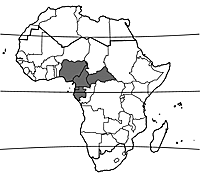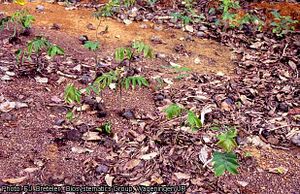Detarium macrocarpum (PROTA)
Introduction |
| General importance | |
| Geographic coverage Africa | |
| Geographic coverage World | |
| Medicinal | |
| Timber | |
| Conservation status | |
Detarium macrocarpum Harms
- Protologue: Bot. Jahrb. Syst. 30: 78 (1901).
- Family: Caesalpiniaceae (Leguminosae - Caesalpinioideae)
Origin and geographic distribution
Detarium macrocarpum occurs in south-eastern Nigeria, Cameroon, Central African Republic, Equatorial Guinea and Gabon.
Uses
The wood, often traded as ‘mambode’, ‘enouk’ or ‘alen’ from Gabon, ‘amouk’ from Cameroon and ‘enuk’ from Equatorial Guinea, is used for flooring, joinery, interior panelling, stairs, furniture, cabinet work, turnery and sliced veneer.
In Cameroon the bark is an ingredient of hunting poison.
Production and international trade
Detarium macrocarpum timber is traded in small amounts on the international market, but statistics are not available.
Properties
The heartwood is reddish brown to coppery brown, often with dark brown streaks, and distinctly demarcated from the 7–10 cm wide, pinkish sapwood. The grain is straight or interlocked, texture medium.
The wood is medium-weight, with a density of 480–660 kg/m³ at 12% moisture content. It air dries slowly, with minimal risk of distortion and checking. The rates of shrinkage from green to oven dry are 3.3–4.3% radial and 4.8–6.0% tangential. Once dry, the wood is moderately stable in service. At 12% moisture content, the modulus of rupture is 83–115 N/mm², modulus of elasticity 11,100–13,100 N/mm², compression parallel to grain 46–64 N/mm² and Monnin side hardness 3.2–4.6.
The wood saws and works satisfactorily with moderate blunting effect on saw teeth and cutting edges. However, the presence of resin may cause some difficulties. The use of a filler is needed to obtain a good finish. Pre-boring is recommended in nailing and screwing. The wood glues satisfactorily except when much resin is present. It is moderately durable, being only moderately resistant to fungi, termites and marine borers. The sapwood is susceptible to dry-wood borers. The wood is moderately permeable to preservatives.
Description
- Medium-sized to very large tree up to 60 m tall; bole branchless for up to 20 m, usually straight, cylindrical, up to 150(–200) cm in diameter, with small buttresses or slightly swollen at base; bark surface fissured, becoming scaly, silvery grey to dark grey or greyish brown, inner bark hard, fibrous, brown outside, pinkish inside; crown dome-shaped; twigs glabrous.
- Leaves alternate, paripinnately or imparipinnately compound with 8–20 leaflets; stipules minute, early caducous; petiolules 5–7 mm long; leaflets alternate, ovate to elliptical, 4–8 cm × 2–4.5 cm, slightly unequal at base, acuminate at apex, papery, with translucent dots, glabrous, pinnately veined with many lateral veins.
- Inflorescence an axillary, lax panicle c. 8 cm long, glabrous.
- Flowers bisexual, slightly zygomorphic; pedicel 2–3 mm long; sepals 4, ovate to lanceolate, c. 5 mm long, 1 slightly broader than other 3, whitish, glabrous outside, hairy inside; petals absent; stamens 10, free, c. 5 mm long; ovary superior, ellipsoid, c. 2 mm long, densely hairy, 1-celled, style c. 3 mm long, curved.
- Fruit a drupe-like, globose to ovoid pod 7–8(–10) cm in diameter, slightly flattened, indehiscent, smooth and olive-green, pulp pale green and fibrous, stone up to 6 cm in diameter, wrinkled, 1-seeded.
- Seedling with epigeal germination; hypocotyl 6–14 cm long, epicotyl 13–28 cm long; cotyledons thick and fleshy, spoon-shaped; first leaves alternate, with 8–10 leaflets.
Other botanical information
The fruits usually ripen in the dry season. Elephants eat them and disperse the stones. Duikers feed on the fruit pulp, but usually do not swallow the stones and thus do not play an important role in seed dispersal, although the yellow-backed duiker may swallow the stones. Gorillas, chimpanzees, mandrills and pigs can break the tough wall of the stone and eat the seed.
Detarium comprises 3 species and is confined to Africa. It is related to Copaifera. The 3 species are morphologically quite similar, but ecologically different.
Ecology
Detarium macrocarpum occurs in humid lowland forest, also in gallery forest. In Equatorial Guinea and Gabon it is usually found inland and not close to the coast. The annual rainfall in the area of distribution is about 1400 mm. Detarium macrocarpum usually occurs on well-drained sites.
Management
In general, larger trees of Detarium macrocarpum occur scattered and in low densities in the forest. In south-western Cameroon the average density of boles of more than 60 cm in diameter is 0.07 per ha, with an average wood volume of 0.73 m³/ha. In Gabon the average wood volume has been recorded as 0.08 m³/ha only. Freshly harvested logs are reported to float in water, and can thus be transported by river. The durability in the forest is moderate, and it is recommended to treat the logs with preservatives or to process them rapidly.
Elephants often feed on the bark and the bole is often damaged and swollen at the base. However, the bark fibres break apart, preventing the elephants from removing large slabs.
Genetic resources
Detarium macrocarpum is not very widespread and occurs scattered in the forest, usually in low densities. This may make it liable to genetic erosion and caution is needed in case of increasing exploitation.
Prospects
Detarium macrocarpum is a valuable timber tree that, however, occurs in too low density to be commercially important. Virtually no technical information exists on many aspects, including growth rates, propagation and management in natural forest and plantations, and much research is still needed to assess its possibilities for exploitation on a sustainable basis.
In view of the presence of edible fruits and seeds and widespread medicinal applications in other Detarium spp., phytochemical and pharmacological investigations of Detarium macrocarpum are recommended.
Major references
- CIRAD Forestry Department, 2009. Amouk. [Internet] Tropix 6.0. http://tropix.cirad.fr/ africa/amouk.pdf. April 2010.
- Neuwinger, H.D., 1996. African ethnobotany: poisons and drugs. Chapman & Hall, London, United Kingdom. 941 pp.
- Neuwinger, H.D., 1998. Afrikanische Arzneipflanzen und Jagdgifte. Chemie, Pharmakologie, Toxikologie. 2nd Edition. Wissenschaftliche Verlagsgesellschaft mbH, Stuttgart, Germany. 960 pp.
- Vivien, J. & Faure, J.J., 1985. Arbres des forêts denses d’Afrique Centrale. Agence de Coopération Culturelle et Technique, Paris, France. 565 pp.
- White, L. & Abernethy, K., 1997. A guide to the vegetation of the Lopé Reserve, Gabon. 2nd edition. Wildlife Conservation Society, New York, United States. 224 pp.
Other references
- Aubréville, A., 1968. Légumineuses - Caesalpinioidées (Leguminosae - Caesalpinioideae). Flore du Gabon. Volume 15. Muséum National d’Histoire Naturelle, Paris, France. 362 pp.
- Aubréville, A., 1970. Légumineuses - Césalpinioidées (Leguminosae - Caesalpinioideae). Flore du Cameroun. Volume 9. Muséum National d’Histoire Naturelle, Paris, France. 339 pp.
- Christy, P., Jaffré, R., Ntougou, O. & Wilks, C., 2003. La forêt et la filière bois au Gabon. Projet Aménagement Forestier et Environnement, Libreville, Gabon. 389 pp.
- de Saint-Aubin, G., 1963. La forêt du Gabon. Publication No 21 du Centre Technique Forestier Tropical, Nogent-sur-Marne, France. 208 pp.
- Keay, R.W.J., 1989. Trees of Nigeria. A revised version of Nigerian trees (1960, 1964) by Keay, R.W.J., Onochie, C.F.A. & Stanfield, D.P. Clarendon Press, Oxford, United Kingdom. 476 pp.
- Léonard, J. & Doucet, J.-L., 1997. Description des plantules de quatre Caesalpiniacées africaines. Bulletin du Jardin botanique national de Belgique 66: 213–221.
- Lewis, G., Schrire, B., MacKinder, B. & Lock, M., 2005. Legumes of the world. Royal Botanic Gardens, Kew, Richmond, United Kingdom. 577 pp.
- Normand, D. & Paquis, J., 1976. Manuel d’identification des bois commerciaux. Tome 2. Afrique guinéo-congolaise. Centre Technique Forestier Tropical, Nogent-sur-Marne, France. 335 pp.
- Tailfer, Y., 1989. La forêt dense d’Afrique centrale. Identification pratique des principaux arbres. Tome 2. CTA, Wageningen, Pays Bas. pp. 465–1271.
- Wilks, C. & Issembé, Y., 2000. Les arbres de la Guinée Equatoriale: Guide pratique d’identification: région continentale. Projet CUREF, Bata, Guinée Equatoriale. 546 pp.
Author(s)
- R.H.M.J. Lemmens, PROTA Network Office Europe, Wageningen University, P.O. Box 341, 6700 AH Wageningen, Netherlands
Correct citation of this article
Lemmens, R.H.M.J., 2011. Detarium macrocarpum Harms. [Internet] Record from PROTA4U. Lemmens, R.H.M.J., Louppe, D. & Oteng-Amoako, A.A. (Editors). PROTA (Plant Resources of Tropical Africa / Ressources végétales de l’Afrique tropicale), Wageningen, Netherlands.
Accessed 5 April 2025.
- See the Prota4U database.



